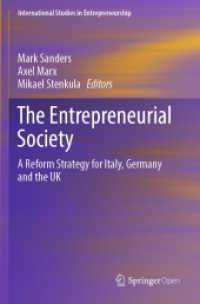Description
The COVID-19 pandemic has worsened health disparities worldwide. Across all nations, the burden of COVID-19 has fallen most heavily on the socially disadvantaged. In the United States, the COVID-19 mortality rate for Black Americans is over twice that of their White American counterparts, and people in prisons have more than double the COVID-19 mortality rate of the general U.S. population. Other social dimensions such as income, gender, sexuality, and immigration status have also played a significant role in COVID-19 infection, hospitalization, and mortality. The Social Epidemiology of the COVID-19 Pandemic provides an interdisciplinary analysis of the pandemic's effect across populations and its disproportionate impact on vulnerable groups in society, including racial/ethnic minority, immigrant, and incarcerated populations. Written by leading international scholars, this essential volume describes how the COVID-19 pandemic intersects with nearly every social determinant of health, from race and ethnicity to income inequality, and how such interactions compound existing structural disadvantages. Using examples from upper-middle and high-income countries such as the United States, contributing experts delve into the differential impacts of COVID-19 by major social determinants of health and reveal the resultant effect of pandemic-related policy on health outcomes. Together, these authors underline the urgent need for further integration of social epidemiology into public health decision-making to ensure that every population receives the care it requires. Drawing from research across epidemiology, sociology, psychology, and public policy, The Social Epidemiology of the COVID-19 Pandemic illuminates the stark disparities exacerbated by the COVID-19 pandemic and the valuable insights from social epidemiology that can inform a more equitable pandemic response.
Table of Contents
ForewordSir Michael Marmot Chapter 1. IntroductionStephen S. Morse, Ichiro Kawachi, and Dustin T. Duncan Chapter 2. COVID-19 across the Life Course Diana Kuh and Joanna BlodgettChapter 3. Social Class, Poverty, and COVID-19 Alicia R. Riley and M. Maria GlymourChapter 4. Race/Ethnicity and COVID-19 Merlin Chowkwanyun, Dean Robinson, and Adolph Reed Chapter 5. Racism, Stigma, and the COVID-19 Pandemic David H. Chae, Kara W. Chung, Diamond J. Cunningham, Connor D. Martz, Ethan A. Smith, and Michael CunninghamChapter 6. International Migration, Immigrant Health, and Social Policies during the COVID-19 Pandemic: A Case Study of Six Countries Sarah Diaz, Rama Hagos, Tod Hamilton, and Carmela Alc?ntara Chapter 7. Explaining Binary Sex and Gender Patterns in the Direct and Indirect Health Effects of COVID-19: Biologic and Social Constructions of DifferenceLisa M. Bates Chapter 8. Sexual and Gender Minorities in the COVID-19 PandemicLiadh Timmins, Kevalyn Bharadwaj, Krish J. Bhatt, and Dustin T. Duncan Chapter 9. Disability and Ableism in the COVID-19 PandemicKrish J. Bhatt and Bonnielin K. SwenorChapter 10. COVID-19 and Mass Incarceration Sandhya Kajeepeta and Seth Prins Chapter 11. Income Inequality and COVID-19 Ichiro Kawachi Chapter 12. Work during and after the Pandemic Susan E. Peters and Gregory R. WagnerChapter 13. Housing Conditions in the COVID-19 PandemicSebasti?n Sandoval Olascoaga, C?sar Garc?a L?pez, Gabriela Zayas del Rio, and Mariana C. Arcaya Chapter 14. Neighborhoods and COVID-19: Current Research, Future Directions, and Place-Based Interventions Byoungjun Kim, Adam Whalen, Andrew Rundle, Christopher Morrison, Charles Branas, and Dustin T. DuncanChapter 15. Social Capital, Social Cohesion, and COVID-19 Ichiro Kawachi and Yusuf Ransome Chapter 16. Religion, Spirituality, and COVID-19 Yusuf Ransome, Tamara L. Taggart, and Ichiro Kawachi Chapter 17. Trust in Public Health Communications and the COVID-19 Pandemic Rachel McCloud, Mesfin Awoke Bekalu, and K. Vish Viswanath Chapter 18. COVID-19, Welfare States, and Social Policies Wasie Karim, Emilie Courtin, and Peter Muennig AppendixIndex
-

- 洋書電子書籍
-
急性脳卒中(第3版)
Acute…
-

- CD
- 吉田知加/こうぶつ




